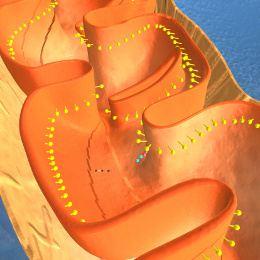Mitochondrial myopathies are a group of diseases and not just one particular disease. However, all these diseases affect only one thing in our body―the mitochondria.

Those who have studied human genetics or similar sciences, know that mitochondria are present in all our nerve cells and deal with the functions of our muscles. These mitochondria are what provide energy to our cells, which in turn help in movement of muscles, etc. If these mitochondrial problems affect only the muscles, the disease is known as a mitochondrial myopathy, where
myo stands for muscle and
pathos stands for disease. On the other hand, if they affect both, the muscle and the brain, it is called a mitochondrial encephalomyopathy, where
encephalo stands for brain.
Group of Mitochondrial Myopathy Diseases
- Kearns-Sayre syndrome (KSS)
- Mitochondrial DNA Depletion Syndrome (MDS)
- Mitochondrial encephalomyopathy, lactic acidosis, and stroke-like episodes (MELAS)
- Mitochondrial Neurogastrointestinal Encephalomyopathy (MNGIE)
- Myoclonus Epilepsy with Ragged Red Fibers (MERRF)
- Progressive External Ophthalmoplegia (PEO)
- Neuropathy, Ataxia, and Retinitis Pigmentosa (NARP)
- Leigh Syndrome
- Pearson Syndrome
What Are The Causes?
All of you know that our body is made up with the help of genes. The type of genes that affect mitochondrial diseases are those that make proteins; these work inside the mitochondria. Mitochondria refers to a lot of energy factories, its singular form is called mitochondrion. Inside each of these mitochondrions, fuel molecules obtained from food are used to manufacture or produce ATP―the energy molecule. This process needs oxygen; there aren't many proper ways of producing the ATP outside the mitochondrion.
Now what happens is this. Proteins get the fuel molecules―the fats and sugar inside the mitochondrion. Then, they extract energy from the fuel molecules. This extracted energy is in the form of electrons, which we know as charged particles. These charged particles are then used to make ATP. The proteins we talk about here, exist in five groups, called complexes I, II, III, IV, and V. Complexes I-IV are called
electron transport chain as they actually manage the electrons through the whole process. Complex V is called the
ATP synthase as it actually lets out the ATP.
We have seen the group of mitochondrial diseases. These diseases are differentiated by the type of deficiency in a particular complex. At times, the names are also related to the diseases, e.g.: complex I deficiency. A defected mitochondria does not only not produce the ATP, but also becomes home to a lot of unused oxygen and fuel molecules. This can prove to be dangerous.
What Symptoms Should You Look Out For?
Though fatigue, weakness, and muscle wasting are the most common symptoms, it has been observed that the prominence is more in muscles that control the eye and the eyelid movements. Progressive External Ophthalmoplegia (PEO) stands for the slow paralysis of the eye movements, while the term that is used for upper eyelid drooping is
ptosis. One thing we need to realize here is the severity of these symptoms. They vary even in people affected in the same family. Some people might not be able to swallow food (change in diet recommended), while some may find it difficult to move around and might need the help of a wheelchair.
Now let us talk about mitochondrial encephalomyopathy. These symptoms are similar to the ones we read above but have some additions. For example, in this case, we also have the additional symptoms of headaches and migraines. Another common symptom of the mitochondrial encephalomyopathy is hearing impairment. Few of the other symptoms are loss of vision due to shrinking of the optic nerve. This is called
optic atrophy. There are some cells that line the eye on its back. Degeneration of these cells or
retinopathy as it's called, can also cause loss of vision.
Are There Any Treatments?
A lot of institutes around the world are researching for the cure of mitochondrial myopathy and encephalomyopathy. Though no cure as such has yet been discovered, we can still look for hope in a way. Prognosis is very difficult, but the symptoms such as ptosis and difficulty in swallowing of food can be cured, as treatments for those are already available. You can shift to an easy-to-swallow food diet, and for ptosis, you can use 'ptosis crutch' spectacles.
Since the disease affects the genes, they are hereditary. These diseases, however, are not contagious and do not develop due to a particular lifestyle or habit.


 Those who have studied human genetics or similar sciences, know that mitochondria are present in all our nerve cells and deal with the functions of our muscles. These mitochondria are what provide energy to our cells, which in turn help in movement of muscles, etc. If these mitochondrial problems affect only the muscles, the disease is known as a mitochondrial myopathy, where myo stands for muscle and pathos stands for disease. On the other hand, if they affect both, the muscle and the brain, it is called a mitochondrial encephalomyopathy, where encephalo stands for brain.
Those who have studied human genetics or similar sciences, know that mitochondria are present in all our nerve cells and deal with the functions of our muscles. These mitochondria are what provide energy to our cells, which in turn help in movement of muscles, etc. If these mitochondrial problems affect only the muscles, the disease is known as a mitochondrial myopathy, where myo stands for muscle and pathos stands for disease. On the other hand, if they affect both, the muscle and the brain, it is called a mitochondrial encephalomyopathy, where encephalo stands for brain.